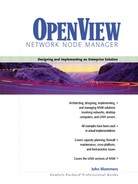Capacity Planning
NNM provides the as-built network topology needed for capacity planning. HP NetMetrix can provide the existing performance metrics. HP Service Simulator can import both topology (see Figure 9-12) and performance data to create a baseline simulation model of your network. What’s next, then?
Figure 9-12. A simple network topology in service simulator.
This is one of the tutorials provided with the Service Simulator product. Complex networks are dealt with using hierarchical container objects. In practice, the topology can be imported directly from NNM and then edited to define various what-if scenarios. After traffic profiles are created, the simulation is allowed to run until it reaches a steady state.

Before you can use the simulator and write a capacity plan, you must have a question to answer. The kinds of questions you might consider are as follows:
Can the network handle another 1000 users?
What happens when I consolidate 100 mail hubs into 10?
What upgrades are needed to support our new ERP application?
Will adding a second T-1 line meet response time requirements?
Can the network handle the new print-on-demand technology?
All of these are “what if?” questions. You typically take the baseline simulation model created with Service Simulator, make changes postulated in the question, and let the simulator calculate the impact on response time and circuit utilization (Figure 9-13).
Figure 9-13. Simulation results for Ethernet delay.
One of the outputs of the simulator is the Ethernet delay versus time. You see that the steady state is reached early in the simulation and that the worst delay is only about 4 milliseconds.

If you are planning to add a new application to the network, you need data about its traffic requirements. You also need LAN analyzer traces of the most commonly used transactions. These can be imported into the simulator. Edit the network topology, move servers around, add new clients and servers, modify line speeds, and run the simulator to see what happens. The basic methodology is shown in Figure 9-14.
Figure 9-14. Capacity Planning Methodology.
The simulation tool is the core of the capacity planning methodology. A lot of time is saved by importing network topology from NNM, performance data from NetMetrix, and transaction traces from LAN analyzers. Armed with a question, you run the simulator to find out if the network can meet the response time and utilization requirements. If requirements aren’t met, go back and move servers around, add bandwidth, change the topology, or reduce the traffic load until they are. When you validate that the network design can deliver the desired performance, you can produce the results to prove it with graphs and charts.

Do any circuits operate at capacity? Are transaction response times within acceptable limits? If not, then change some parameters and try again.
